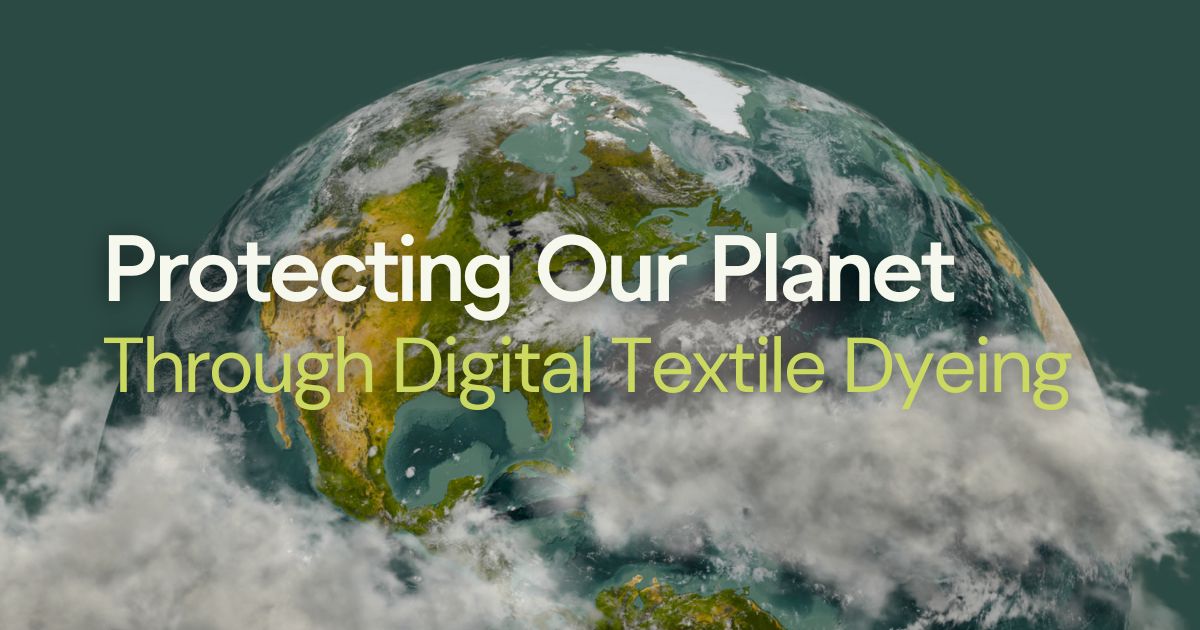 Celebrating its 55th anniversary this year, Earth Day continues to raise awareness around sustainable ways of protecting the environment. The need for action around environment protection is no longer a distant concern – rather an immediate concern. In fact, a recent survey by GlobeScan and WWF revealed that 63% of people view water pollution as a “very serious” environmental issue, ranking it even higher than climate change. With traditional textile dyeing contributing heavily to the water crisis, it's time to change. Revolutionary, clean-tech innovations are setting new benchmarks for sustainability in the textile industry. Let’s discover how brands and textile manufacturers can Protect Our Planet Through Digital Textile Dyeing.
Celebrating its 55th anniversary this year, Earth Day continues to raise awareness around sustainable ways of protecting the environment. The need for action around environment protection is no longer a distant concern – rather an immediate concern. In fact, a recent survey by GlobeScan and WWF revealed that 63% of people view water pollution as a “very serious” environmental issue, ranking it even higher than climate change. With traditional textile dyeing contributing heavily to the water crisis, it's time to change. Revolutionary, clean-tech innovations are setting new benchmarks for sustainability in the textile industry. Let’s discover how brands and textile manufacturers can Protect Our Planet Through Digital Textile Dyeing.
The Textile Industry’s Role In The Water Crisis
Traditional textile dyeing is one of the most water-intensive processes in the textile and fashion sector. It’s responsible for nearly 20% of global industrial water pollution and consumes approximately 93 billion cubic metres of water annually – enough to meet the needs of 5 million people. In certain regions, textile wastewater contributes to 70% of surface water pollution, devastating local ecosystems and communities.
Despite this alarming data, demonstrating the textile industry’s role in the water crisis, many brands and textile manufacturers continue to prioritise operational water efficiency. Overlooking the larger impact of wastewater generation and value chain dependencies. The call to action is clear: brands and textile manufacturers must adopt sustainable and water-responsible practices. The first step could start with clean-tech alternatives like digital textile dyeing.
The Need For Industry Collective Action
Experts and consumers alike are calling for urgent change. According to the Future Water Agenda report:
- 94% emphasise the need for water stewardship to be part of nature-based sustainability solutions.
- 80% of experts agree water needs the same level of urgency as climate change.
- More than two-thirds of global consumers want companies to better integrate water stewardship into their sustainability strategies.
It’s not just public pressure driving this shift – investors are also demanding change. Nearly 40% of experts believe investors have the most power to drive corporate transformation in water stewardship. The future of fashion and textiles depends on recognising the need for industry collective action and the implementation of clean-tech solutions like digital textile dyeing.
Protecting Our Planet Through Digital Textile Dyeing
Unlike traditional dyeing methods that rely on massive water usage and harmful chemicals, our process uses a precise, digital technology. This process protects public health and local ecosystems by minimising chemical exposure and pollution. Thereby demonstrating how digital textile dyeing paves the way for brands and textile manufacturers to be sustainable in their dyeing processes.
At Alchemie Technology we've pioneered a breakthrough solution to one of the textile industry's biggest environmental challenges. Our digital textile dyeing systems drastically reduce water consumption and wastewater altogether, giving the planet a cleaner way to do textile dyeing.
To protect our planet and address the water crisis, brands and textile manufacturers must seize the power they have to transition from the textile industry's polluting processes. Our digital textile dyeing technologies provide a scalable, sustainable alternative that significantly reduces wastewater, slashes water consumption, and eliminates the need for harmful chemicals.
Together, we can protect our planet through digital textile dyeing and build a future where fashion and environmental responsibility go hand in hand.
Reach out to us at enquiries@alchemietechnology.com to transition to sustainable textile dyeing.
